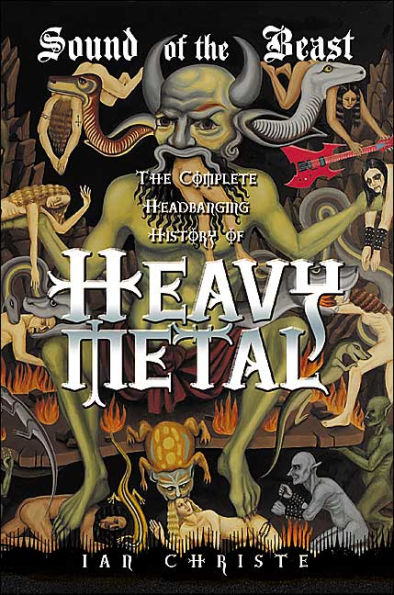Read an Excerpt
Sound of the Beast
The Complete Headbanging History of Heavy Metal
Chapter One
The 1970s:
Prelude to Heaviness
- February 13, 1970: Black Sabbath debut released
- June 4, 1971: Black Sabbath gold in America
- December 1975: Judas Priest records Sad Wings of Destiny
- October 28, 1978: Kiss Meets the Phantom of the Park airs on NBC
- December 11, 1978: last date of Ozzy Osbourne's final tour with Black Sabbath
Heavy metal came into being just as the previous generation's salvation, rock and roll, was in the midst of horrific disintegration. Four deaths at a free Rolling Stones concert at Altamont Raceway in December 1969 had shaken the rock community and left the youth culture disillusioned with pacifist ideals. Then, while Black Sabbath was marking the pop charts in April 1970, Paul McCartney effectively announced the breakup of the Beatles. Instead of comforting their audience in an uncertain world, rock giants Janis Joplin, Jimi Hendrix, and Jim Morrison of the Doors all were dead of drug overdoses within a year.
Shortly after JFK, RFK, and MLK fell to the bullets of assassins, so, too, were the originators of rock and roll falling to naïve excess. Jaded and frustrated, the Love Generation that created counterculture left the cities in droves, returning to their homelands, heading to the hills -- anything to exorcise the communal nightmares of utopia gone awry. It was the end of the 1960s and of all they represented. As the nonviolent flower children gave way to the militant Black Panther party, Kent State campus massacres, and increasingly violent street revolts by frustrated students in Paris, Berlin, and Italy, it was out with the old hopes everywhere and in with the new pragmatism.
Black Sabbath seemed to thrive on such adversity, never pretending to offer answers beyond the occasional exhortation to love thy neighbor. Though legend likes to portray the band as scraggly underdogs, the band's debut soon took to the British Top 10 and stayed there for months. The band's maiden American tour, planned for summer 1970, was canceled in light of the Manson Family murder trial. There was an extremely inhospitable climate in the United States toward dangerous hippies. Still, the record charted high in America and sold over a half million copies within its first year.
Vertigo Records scrambled to get more material from its dire and mysterious conscripts, interrupting Sabbath's nonstop touring for another recording session in September 1970. Hotly rehearsed as ever, and with intensified creative purpose, the band emerged after two days with the mighty Paranoid, its bestselling album and home of classic Sabbath songs "War Pigs," "Paranoid," and "Iron Man."
While Paranoid retained the haunting spirit of Black Sabbath, the themes of the second album were less mystical and more tangible. Obsessed with damage and loss of control, Ozzy Osbourne in plaintive voice bemoaned the ills of drug addiction in "Hand of Doom," nuclear war in "Electric Funeral," and battle shock in "Iron Man." Like the mesmerizing title track of Black Sabbath, the soul of Paranoid still grew from an occult-oriented number, "Walpurgis," whose imagery powerfully summoned "witches at black masses" and "sorcerers of death's construction." When recorded for Paranoid, the song was slightly rewritten as "War Pigs," a cataclysmic antiwar anthem indicting politicians for sending young and poor men off to do the bloody work of banks and nations.
Now Sabbath was becoming experienced not just as musicians but as generational spokesmen. If change was to be brought by music, Sabbath lyricist Geezer Butler saw that he would have to fight ugliness on the front lines. The new Black Sabbath songs sought peace and love -- not in the flower patches of Donovan and Jefferson Airplane but in the grim reality of battlefields and human ovens. Ozzy Osbourne delivered these lyrics as if in a trance, reading messages of truth written in the sky.
Billboard magazine blithely wrote that Paranoid "promises to be as big as their first," and indeed the songs "Paranoid" and "Iron Man" both came close to cracking the U.S. Top 40 singles chart. It seemed that the music of the 1960s had existed just to ease audiences into Sabbath's hard prophecies. Written allegedly in less time than it takes to play, the frantic three-minute single "Paranoid" sent Sabbath's second album to number one on the British charts and number eight in America.
While the hierarchy of rock and roll collapsed around them, spectators were overwhelmed by the intuition that Black Sabbath was beginning an entirely new musical era. "Paranoid is just like an anchor," says Rob Halford, singer of Judas Priest, a local Birmingham band. "It really secures everything about the metal movement in one record. It's all there: the riffs, the vocal performance of Ozzy, the song titles, what the lyrics are about. It's just a classic defining moment."
Sabbath soon found squatters in their huge sonic space. Inspired acolytes, signed to one-off record deals while playing the university student-union circuit, brought early and short-lived aftershocks. Japan's outlandish Flower Travelin' Band and South Africa's clumsy Suck went so far as to record Black Sabbath cover songs as early as 1970, when the vinyl on the original records was barely dry. Others were motivated to mimic Sabbath by the prospect of a quick buck. A 1970 album by Attila presented young Long Island crooner Billy Joel (then a rock critic and sometime psychiatric patient) dressed in warrior garb, playing loud Hammond B3 organ to a hard rock beat, damaging ears with the songs "Amplifier Fire" and "Tear This Castle Down."
Before Black Sabbath, "heavy" had referred more to a feeling than a particular musical style, as in hippiespeak it described anything with potent mood. Jimi Hendrix and the Beatles often wrote songs that pointed toward a heavy break, a bridge between melodies that tried to resolve conflicting emotions and ideas. The "metal" in heavy metal put a steely resilience to that struggle, an unbreakable thematic strength that secured the tension and uninhibited emotion. As ordained by Black Sabbath, heavy metal was a complex maelstrom of neurosis and desire formed into an unbending force of deceptive simplicity. It had omnivorous appetite for life.
Sound of the Beast
The Complete Headbanging History of Heavy Metal. Copyright © by Ian Christe. Reprinted by permission of HarperCollins Publishers, Inc. All rights reserved. Available now wherever books are sold.



